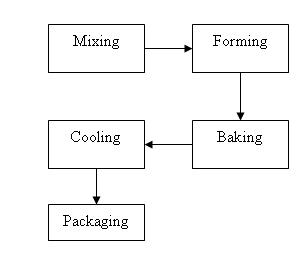Difference between revisions of "Information about biscuits, cookies and crackers"
m (Changed protection level for "Information about biscuits, cookies and crackers" ([edit=sysop] (indefinite) [move=sysop] (indefinite))) |
|
(No difference)
| |
Revision as of 13:26, 20 February 2013
Back to EFFICENCY FINDER OF FOOD INDUSTRY
Back to Information about bread, biscuits & cakes production
1. GENERAL DESCRIPTION:
- 1. General Flowsheet of biscuits, cookies and crackers production
Figure 1: Flow sheet diagram of manufacturing, Literature: Caballero, B., Finglas, P., Trugo, L.: Encyclopedia of food science and nutrition
- 2. Description of techniques, methods and equipment
The basic characteristic of biscuits, cookies and crackers that separates them from other baking products is their low moisture content (below 5%). The principal ingredients are a cereal base which can be wheat, oat or, barley, rye or rice, fat and sugar. Water is also added to the dough but it is no major component because it evaporates during baking.
Biscuits classification varies from country to country. One facility is to classify them on their type of dough. The two main categories are hard and short doughs. Crackers are made from hard doughs as are semi-sweetened, unsweetened and savory biscuits. Soft doughs are named for their higher content of fat and sugar which result in a softer consistency. They are more closely to cake dough than to bread dough.
Classification can also be based on the method of processing:
- Sheeting and cutting (used for making crackers)
- Rotary molding (used for short doughs which require a not too sticky consistence)
- Wire cutting (also used for short doughs)
- Depositing (used for soft doughs)
Crackers made from hard doughs
Crackers are characterized by their low level of fat and sugar. They are often used as a base of a savory topping such as cheese or tomato. They can further be subdivided into those that are fermented, including soda crackers, saltines and cream crackers and those that are chemically leavened like the snack crackers.
Soda crackers
They have their name from the sodium bicarbonate which is added to the dough. Their shortening content is about 8%. Normally they are quite dry and bland.
Saltines
They are a smaller and more dainty type of soda crackers with an increased amount of shortening.
Cream crackers
Despite their name they content no cream. They have just a slightly higher fat content than soda crackers (12-18%). They have a final moisture content of 3-4% which is relatively high for a cracker. Because of the increased fat content the cracker is quite soft and will not crumble.
Snack or savory crackers
They are sprayed with hot oil as they leave the ovens. Also a topping is applied before baking to add flavour. Typical toppings include herb, cheese, salt and/or chicken. The crackes can also be decorated with small seeds such as poppy or sesame. Usually they contain also some sugar which also adds flavour and texture. Normally they are chemically leavened, but they can also be made from fermented doughs.
Sweet and semisweet biscuits made from hard doughs
The dough of this kind of crackers has higher contents of sugar and fat. Unlike cracker doughs it is chemically leavened.
Biscuits or cookies made from short doughs
The vast majority of worldwide consumed biscuits and cookies are made from short doughs. The range of size, shapes, flavours and ingredients is huge, but some consistent requirements exist. The used flour is usually weak and the proportions of fat and sugar can range up to 100 and 200% of flour weight. The two main processes for forming short dough biscuits are rotary molding and wire cutting.
Biscuits and cookies made from soft doughs
Soft doughs are typically rich in fat (65-76% of flour weight) and sugar (35-40%). Weak flour is used and mixing is in a two-stage process. Often rich and expensive ingredients are used in soft doughs such as almonds, coconut flour or cocoa.
The basic steps in manufacturing are:
1. Dough mixing The raw materials are received in bulk and are automatically metered into dough mixers. Small ingredients (eg. salt) are added by hand. The processes are accomplished with three principal types of mixers: vertical spindle mixers, horizontal drum mixers and continuous mixers.
2. Formation The forming step is specific to each product type. There are three processes used to form cookie and cracker dough:
- Cutting or stamping
- Rotary molding
- Extruding
3. Backing Baking usually takes places in tunnel ovens. The ovens themselves may be direct or indirect fired, gas or electric and vary in length and band width. The backing time and temperature depend on the nature of the dough.
4. Cooling
After baking biscuits are cooled by conveying them around the plant for a set of time period.
- 3. Temperature ranges and other parameters
- 4. Benchmark data
2. NEW TECHNOLOGIES:
- a) Changes in the process
- b) Changes in the energy distribution system
- c) Changes in the heat supply system
Reference: Caballero, B., Finglas, P., Trugo, L.: Encyclopedia of food science and nutrition, Academic Pr. Inc., 2003, pages 524-538
Back to EFFICENCY FINDER OF FOOD INDUSTRY
Back to Information about bread, biscuits & cakes production
